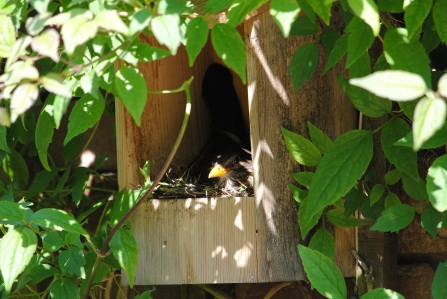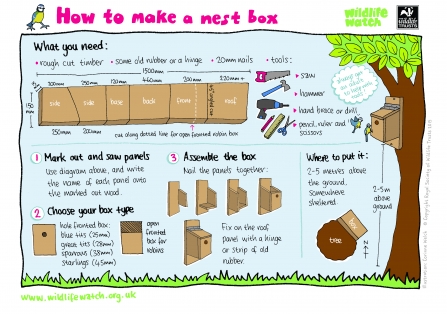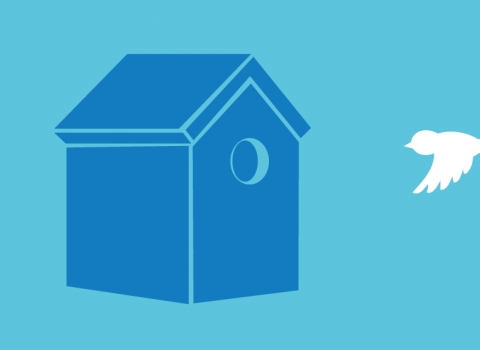The total area of all gardens in Northern Ireland exceeds that of our nature reserves, and as development destroys trees, hedges and old buildings, natural nesting sites are in decline. Nest boxes placed in gardens can make a real difference to the success or failure of a breeding species in an area, especially when accompanied by the regular supply of suitable food and water.

Blackbird in nest box (c) Amy Lewis
You will need:
- Rough cut, unplaned, untreated softwood timber, 15cm wide x 150cm long x 15 mm thick
- Scrap rubber, such as an old inner tube from a tyre
- Galvanised 20mm (3/4") nails
- Saw
- Hammer
- Drill
- Pencil and ruler
- Scissors
Design
There is no standard, accurate design for a nestbox. Birds do not insist on their nest sites being mathematically precise! What they do require is a nest site which is secure and weatherproof, and as safe as possible from predators. Dimensions need not be precise; make the box to suit the materials available rather than buying materials to match any given dimensions.
How to make your birdbox:
- Mark out the panels of the future nest box with a pencil and a ruler, and write the name of each panel onto the marked out wood (believe me, this will save confusion later.)
- Saw the panels apart. Please note you will need to make a slanted cut between the front panel and roof at a 45-degree angle
- Front panel: decide which box type you want to make: Hole-fronted tit box - use a hand brace or drill to make a round entrance hole; 25mm diameter - for blue tits 28mm diameter - for great tits 38mm diameter - for sparrows. Open fronted robin box - simply saw off 75mm from the top of the front panel to make a ’window’ entrance
- Start by nailing one of the sides onto the back plate through the back; then nail on the floor (this can be quite tricky - go carefully to avoid splitting the wood); then nail on the other panel
- Nail all the other panels into place except for the roof panel.
- If your carpentry is of a high standard with evenly proportioned panels and snugly fitting joins, you will need to drill some small holes (1-2mm diameter into the floor panel to allow for drainage)
- Fix on the roof panel with a rubber flap ’hinge’ made from scrap rubber. This should cover the join between the roof and back plate completely so as to be waterproof. Nail the rubber into the back plate first, then pull it tightly over the join and nail it onto the roof. The roof should be able to lift away like a lid.
- After construction, the outside only of the box should be treated with a water-based wood preservative product such as 'Cuprinol' or 'Sadolin', (NOT creosote) to prolong its life and help repel water. If using planed timber, clear polyurethane may be used instead.
- A piece of roofing felt fixed to the roof will also prolong the life of the box and render it more waterproof.
Dimensions need not be precise; make the box to suit the materials available rather than buying materials to match any given dimensions.
Nestbox location
Whether fixed to a tree or a wall, the height above ground is not critical to most species of bird, so long as the box is clear of inquisitive humans and prowling cats. If there is no natural shelter, it is best to mount a box facing somewhere between south-east and north, to avoid strong direct sunlight and the heaviest rain. The box should be tilted slightly forwards so that the roof may deflect the rain from the entrance.
Some authorities recommend nails to attach the box directly to a tree trunk or branch; others prefer the use of rope or wire right around the box and trunk (remembering to protect the trunk from wire cutting in by the use of a piece of rubber or the like). Both methods are satisfactory, but obviously, annual maintenance is easier if the box is wired and can thus be taken down easily for cleaning.
The number of nest boxes which can be placed in a garden depends on the species you wish to attract. Many species are fiercely territorial, such as Blue Tits, and will not tolerate another pair close by. About 2 to 3 pairs per acre is the normal density for Blue Tits. Other species such as Tree Sparrow, which are colonial nesters, will happily nest side by side.
Do not place your nestbox close to a bird-table or feeding area, as the regular comings and goings of many other birds are likely to prevent breeding in the box.
Annual cleaning of nest boxes
After the end of each breeding season, all nestboxes should be taken down and the old nesting materials removed, and the box should be scalded with boiling water to kill any parasites. Do not use insecticides or flea-powders - boiling water is adequate. Annual cleaning is best carried out in October or November.
Under the terms of the Wildlife (Northern Ireland) Order 1985, if unhatched eggs are found in the box, they can only legally be removed from October to January inclusive, and they must be destroyed! It is illegal to keep them.

Nest box how to guide

